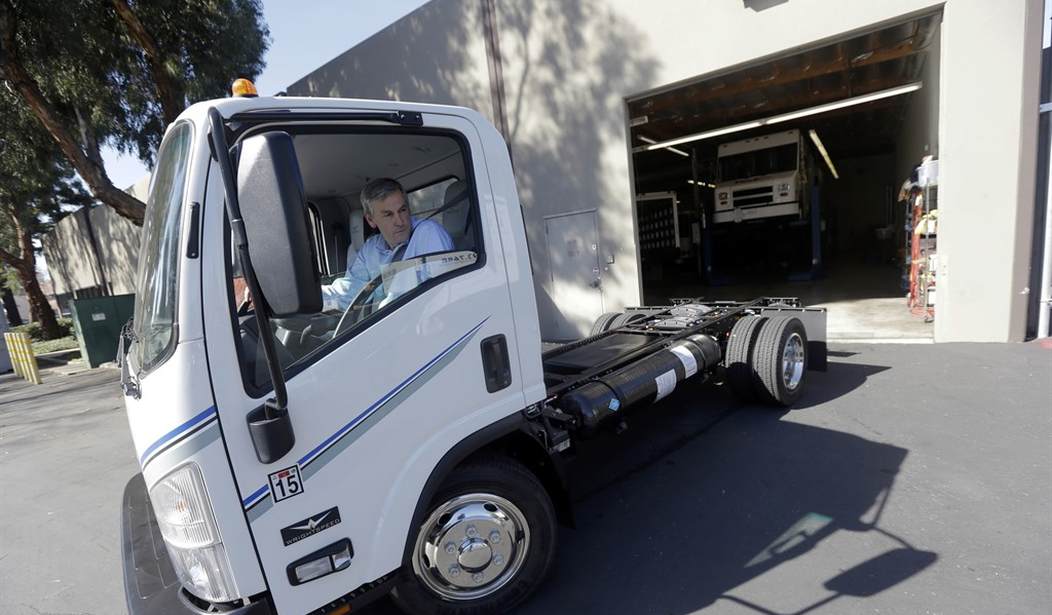The People’s Republic of California is banning diesel trucks in favor of electric vehicles. Not only are California’s goals actually impossible to reach in reality, but attempting to do so will also end up complicating the supply chain and driving up prices.
The Wall Street Journal Editorial Board published an opinion piece on August 31 about the California Air Resources Board’s (CARB) new mandate to make the state’s trucking fleets electric. Drayage operators who drive goods between the distribution centers and ports in California will now be banned from registering any new diesel trucks, WSJ reported; and, as noted above, almost all trucks are supposed to be “zero emissions” by 2035. The state also has a ban on new gas cars by 2035.
The supposed climate change crisis is a fake — it’s as wrong now as it has been for 50+ years. Not only that, but Electric Vehicle (EV) batteries are also actually very toxic to manufacture and dispose of, meaning that switching to them isn’t actually a big win for the environment. That isn’t stopping Commie-fornia from trying to make almost all package delivery, drayage, and box trucks “zero [carbon] emissions” by the year 2035, according to the Wall Street Journal.
Related: Could Industry and Political Pushback Kill the EPA’s Electric Truck Plans?
This crazy new mandate, according to WSJ, would require about 510,000 trucks to meet the zero emissions standards by the deadline year 2035. The Editorial Board called this “regulating first and thinking later.” For instance, installing chargers for the trucks will require millions of dollars.
California’s grid is already strained, partly due to its increasing dependence on unreliable “green” energy. In Joliet, Ill., 30 electric trucks would have required more power than the whole city (population 150,000+), WSJ explained. And California wants 510,000 electric trucks? Trucks to “destabilize” California’s already fragile electric grid and cost about three times as much as new diesel equivalents?
To highlight the hypocrisy of California’s climate goals, the Editorial Board noted that power companies were powering some trucking chargers with diesel generators to keep electric trucks on the road. But truck manufacturers will benefit since WSJ says they made a deal with CARB to up their “zero emission” vehicle sales in exchange for “regulatory flexibility.” The Editorial Board questioned if this constituted an antitrust violation.
As of last month, there were fewer than 700 chargers at trucking depots, yet California’s energy commission estimates 157,000 more will be needed for medium- and heavy-duty trucks by 2030. This would require more than 450 to be constructed each week, while grid upgrades to install chargers could take five to 10 years at minimum.
Then there’s the weight problem. Electric trucks run on two batteries that each weigh about 8,000 pounds. Since trucks must comply with strict federal weight limits, they won’t be able to carry as large a load as diesel big rigs. PepsiCo this year is deploying Tesla’s electric semi-truck to deliver Frito-Lay products, but the trucks can’t go as far delivering soda.
Batteries can power trucks for about 150 to 330 miles between charging, which can take five to eight hours. Longer battery ranges require bigger and heavier batteries, which add more weight and reduce payload. That means more trucks and drivers will be needed, which will increase shipping costs.
Not only that, but WSJ also noted that truckers will likely have to charge their trucks at night instead of driving at that time, making daily commutes more congested with more trucks.
Sure, customers will have to adjust to increased prices, and loads will probably travel more slowly, but California will be able to pay off manufacturers and virtue-signal about stopping the fake climate crisis! Priorities, priorities!










